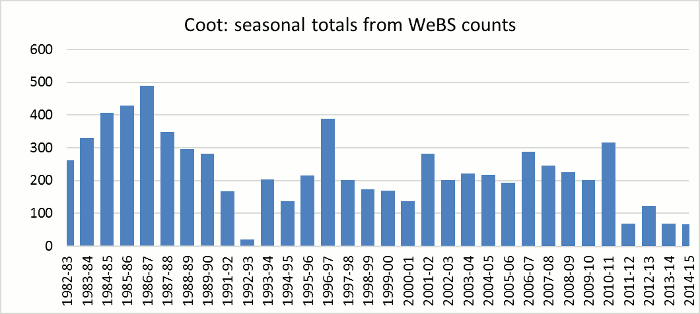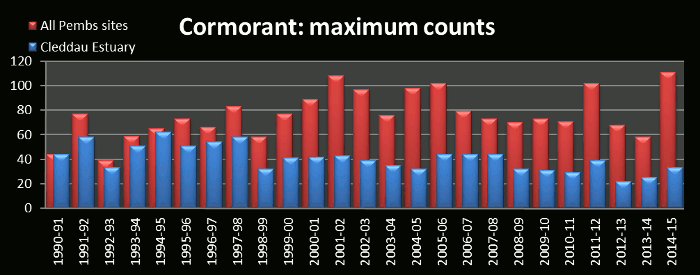Cedar Waxwing - 2015
 Monday, January 30, 2017 at 1:10PM
Monday, January 30, 2017 at 1:10PM
Source: Pembrokeshire Bird Report, 2015.
 Pembrokeshire Avifauna committee | Comments Off |
Pembrokeshire Avifauna committee | Comments Off |  BBRC,
BBRC,  Rarity in
Rarity in  Cedar Waxwing
Cedar Waxwing  Monday, January 30, 2017 at 1:10PM
Monday, January 30, 2017 at 1:10PM
Source: Pembrokeshire Bird Report, 2015.
 BBRC,
BBRC,  Rarity in
Rarity in  Cedar Waxwing
Cedar Waxwing  Monday, January 30, 2017 at 12:47PM
Monday, January 30, 2017 at 12:47PM One was on Skokholm on 1st May 2014. The first confirmed county record and only the third record for Wales (Birds in Wales vol 12 No. 2).
Extract from the 2014 Skokholm Bird Observatory Report "A vocal flyover on 1st May approached from the east, crossed North Plain, quickly reached the Lighthouse and circled briefly before departing high and north (NM et al). Despite its fleeting appearance, good views of both the chestnut underwing and white trailing edge to the secondaries were secured.
 Rarity in
Rarity in  Collared Pratincole
Collared Pratincole  Monday, January 30, 2017 at 12:34PM
Monday, January 30, 2017 at 12:34PM One at St David's Head on 18th November 2014 (Kathy Young-Powell, Mike Young-Powell, Bob Haycock) was the first accepted record for the county and only the second for Wales.
 BBRC,
BBRC,  Rarity in
Rarity in  Blyth's Pipit
Blyth's Pipit  Monday, January 30, 2017 at 10:59AM
Monday, January 30, 2017 at 10:59AM A male at Carew/Cresswell Estuary: 10th to 21st February 2004 (A E Collins, C Jones et al) (2004 Pembs Bird Report).
What was presumed to be a regular returning male was at Angle Bay from 2nd February to 20th February 2005 (D J Astins et al), and from 23rd October 2005 to 9th March 2006 (Clive Hurford et al); then from 1st October 2006 to 2nd March 2007 (C H et al), and again between 14th September 2007 and 1st March 2008. (Pembrokeshire Bird Reports: 2005, 2006, 2007 and 2008).
2017 - Male bird present at the Gann from 21st Jan until 9th Mar at least (PJ, BS et al). Accepted by WRP. (2017 Pembrokeshire Bird Report).
 vagrant in
vagrant in  American Wigeon
American Wigeon  Monday, January 30, 2017 at 10:41AM
Monday, January 30, 2017 at 10:41AM  wildfowl in
wildfowl in  Black Scoter
Black Scoter  Thursday, July 7, 2016 at 10:06AM
Thursday, July 7, 2016 at 10:06AM  The vast majority of redshank wintering in Pembrokeshire are found on the Cleddau Estuary.
The vast majority of redshank wintering in Pembrokeshire are found on the Cleddau Estuary.
Peak counts of redshank declined from the highs of over 1000 birds in the 1980s, when the estuary was considered to be of National Importance for this species. Numbers have stabilised somewhat since the mid 1990s, fluctuating around the 600 level. This reflects the wintering population trends for Wales as a whole.
Redshank prefer to feed in the finer silts of the estuaries on the east coast of Britain where there is a higher density of prey. Mudflats on the western coasts have coarser silt, with less prey, but do have the advantage of milder winters. There is, therefore, a choice between better winter weather with less food, or more food but potentially harsher winters. As the climate changes, and winters on the east coast are less harsh, there is little incentive for birds such as redshank to move further west.
 Thursday, July 7, 2016 at 9:33AM
Thursday, July 7, 2016 at 9:33AM 
Little Grebe counts for the Wetland Bird Survey (WeBS) in Pembrokeshire. Note that data prior to 1995-96 are incomplete.
The distribution and the breeding population of little grebe in Pembrokeshire have increased dramatically in the past twenty years, but this has not been reflected in the wintering population on the estuary system.
The decline on the estuary is largely accounted for by the decline in the wintering population on Westfield Pill, which was considered a stronghold for the species after being dammed in the late 1980s. It is possible that, as the Pill has matured and stabilised as a slightly saline lagoon, conditions may not be quite as suitable for little grebe.
From the mid-1990s, numbers wintering on WeBS sites in the county appeared reasonably stable at around 100 birds, but the total on the estuary has declined. This was almost certainly linked to the milder winters since then. If smaller ponds are not freezing over, then birds are not forced to move to the estuary to feed. In 2013-14 there has been a further decline to around 65 birds. It is likely that there are more birds in the county, particularly on the more recently-created ponds which are not counted for WeBS.
During the cold winter of 2010-11, numbers in the county reached the highest level recorded on WeBS sites. This could be the result of local movements away from small water bodies that are not regularly monitored, or from other parts of the country. Across the UK, numbers declined that year, suggesting that birds either moved further south, and/or succumbed to the bad weather.
The slow but steady increase in Little Grebes across Britain, that appeared to begin in the early 1990s soon after the species was first routinely monitored, has continued in recent years; a period during which numbers have risen concurrently in The Netherlands. This increase has led to large changes in the levels of international and national importance for this species, and the Cleddau Estuary now falls well below the national threshold.
Why the wintering little grebe population in Pembrokeshire as a whole has not increased in line with that in the rest of the UK is unknown
 AH in
AH in  Little Grebe
Little Grebe  Tuesday, January 26, 2016 at 12:27PM
Tuesday, January 26, 2016 at 12:27PM Maximum winter counts from all sites counted for the Wetland Bird Survey in Pembrokeshire. Data after 2000 includes the Teifi Estuary.
Main wintering sites for this species are the Bosherston Lakes, South Hook Pools, Llys-y-fran and Rosebush Reservoirs and Pembroke Millponds. Bicton Reservoirs was a major wintering site, but has not been used much by coot since 2000.
The dramatic decline of the last four seasons reflects the trend across Wales, and Britain as a whole.
The Welsh Bird Report for 2014 suggests there are indications of a severe decline in breeding numbers in several western counties in recent years and wintering numbers have also declined at several sites.

 Tuesday, January 26, 2016 at 11:55AM
Tuesday, January 26, 2016 at 11:55AM Maximum winter counts from all sites counted for the Wetland Bird Survey in Pembrokeshire. Data after 2000 includes the Teifi Estuary.
Main wintering sites for this species are the Cleddau Estuary, Bosherston Lakes, and Llys-y-fran Reservoir. However, large numbers can occur elsewhere, for example 50-60 in Fishguard Harbour in early 2015.

 Sunday, April 27, 2014 at 7:15PM
Sunday, April 27, 2014 at 7:15PM Ruffs have become more frequent in Pembrokeshire during the winter, December to February. Donovan and Rees (1994) noted three records up to 1993 but they have been reported 17 times since, all single birds apart from 2 twice and 3 twice, also 9 together at the Castle Martin ranges on the 17th January 2011.
Graham Rees
 Sunday, April 27, 2014 at 7:08PM
Sunday, April 27, 2014 at 7:08PM One to six birds per year have been noted in the spring between the 3rd March and the 30th June (though late June birds could be males returning from their breeding grounds) but not in every year. However there were only five years between 1982 and 2012 when they were not recorded.

During an exceptionally heavy passage through south-west Britain in April 1987 several waves passed through Pembrokeshire, resulting in records of three at Dowrog, up to six at Skomer and Dale airfield, 12 at Skokholm, 17 at the Gann and up to 46 at Marloes Mere.
Graham Rees
 Sunday, April 27, 2014 at 6:53PM
Sunday, April 27, 2014 at 6:53PM Using records from 1983 onwards as representing the period with countywide observer cover, one to 18 birds per autumn were recorded, with an average of about nine but there were 23 at Skomer on the 15 September 1969.

Records span 6th July to 18th November, peak numbers occurring in September.

Ruffs were seen in coastal areas, on or near the estuaries, by ponds on the islands and mainland and in coastal fields. One seen accompanying Lapwings inland at Pentre Goch, near Felindre Farchog, from the 22nd to the 24th of August 1998 suggests that others were probably missed because of the coastal bias of observer activity.
Graham Rees